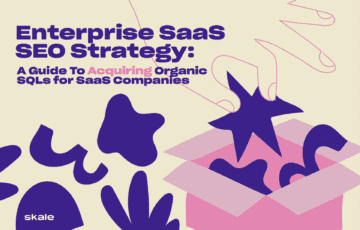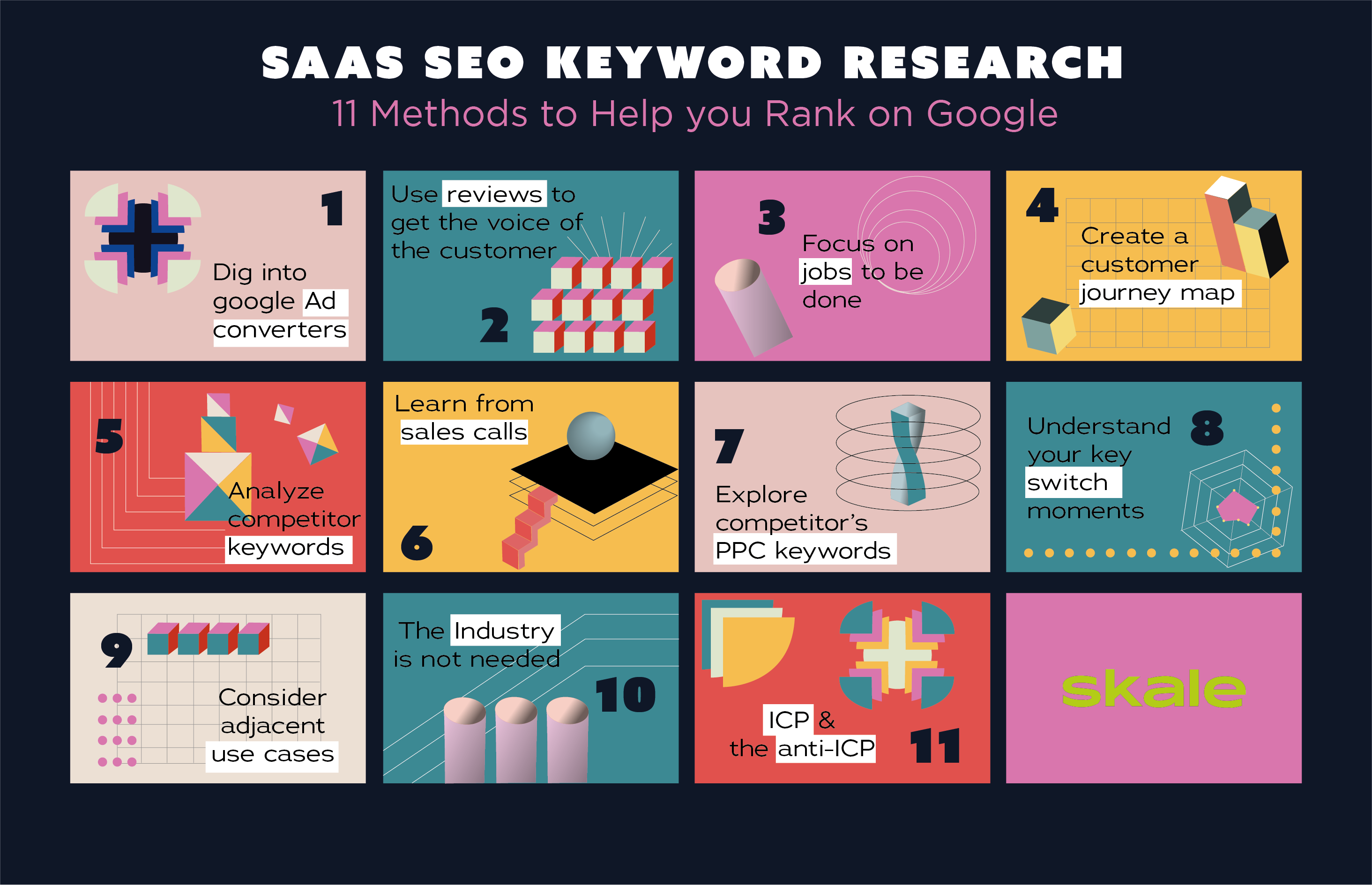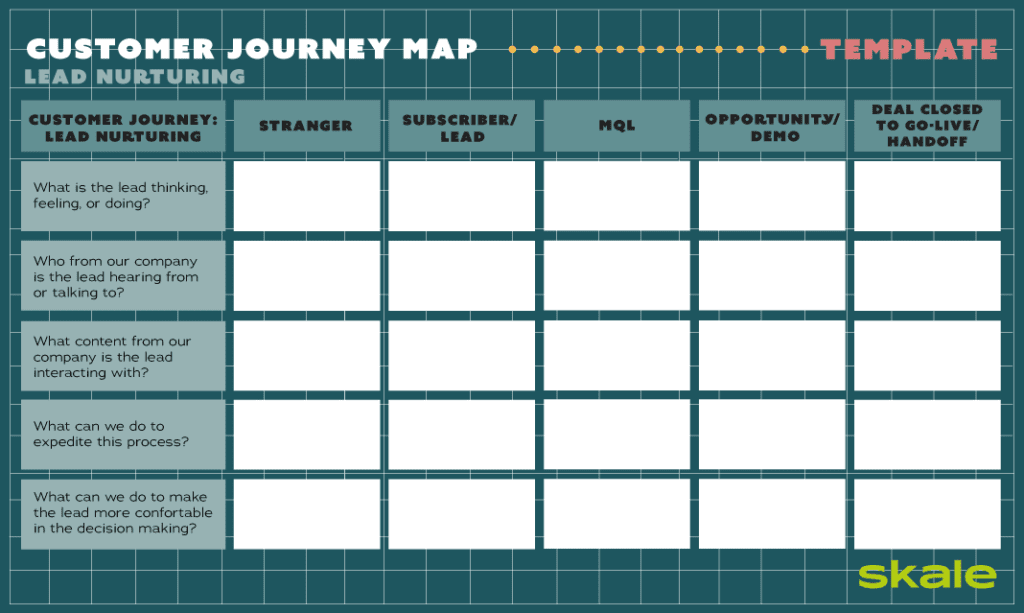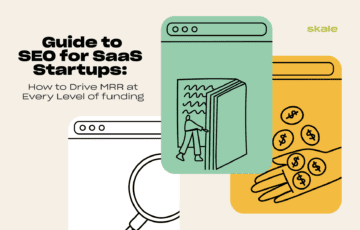
Enterprise SaaS SEO Strategy: A Guide to Acquiring Organic SQLs for SaaS Companies
Unlock the power of Enterprise SaaS SEO with tried-and-tested strategies from the experts & explore SEO tactics for SaaS enterprises.

The things this article is not:
The things this article is:
By the end of this article, you’ll have eight new practical methods to inspire your SaaS keyword research and outrank your competition.
This article also includes three bonus tips covering some misconceptions around keyword research, which can mitigate the amount of SaaS SEO growth you can get. Something to watch out for!
A word of warning: these methods are not quick fixes. These methods will require time and energy from you and your team. They will require you to dedicate resources to your SEO efforts, especially your keyword research process. However, we have used these methods, and they’ve helped me achieve results like 3xing product sign ups in just 3 months, for a Skale client.
If you’re serious about SaaS SEO keyword research, then read on.
Your PPC team is now your best friend. Take them out to lunch, get in their good books, and book in some time to pick their brains (and keyword data sets) Seriously, when SEO teams join forces with PPC teams, you’ll create an SEO force to be reckoned with.
It makes sense: you’re both working in the exact same channel, yet one is paying for the traffic directly, and the other isn’t.
1. Look at the top converting keywords. Ask for a report of all the keywords in the past 30 days that generated a conversion.
Remember to break conversions down and be clear on what the PPC team is paying for. Do you want click-throughs, lead gen, or something else? What do you deem as a conversion, and what’s valuable to you? You should be focusing on your leading indicator of new MRR, such as activations or MQLs. This is how the fastest SaaS companies—like Slack—scaled so rapidly. Not all SEO depends on fancy keyword research tools- but the data can come in handy when you’re looking for real business results.
2. Work out the conversion rate per click-through.
Use this data to understand which new pages and articles you can build out to help generate organic traffic. It’s a great way of understanding what your potential customers want, the words that resonate with them, and their thought process behind getting to your product.
3. Anticipate the number of conversions for your organic pages based on the conversion rates you got for keywords from your PPC team. This will help you set benchmark goals to shoot for with your page content and will also help you prioritize which pages to work on first.

…Or cut out the noise with a SaaS SEO agency
You might not have the time to go through every method on this list, but these top 21 agencies do
Read the listA few things to remember when working with your PPC team on SEO keyword research:
Try to avoid vanity metrics like leads and signups. I used it as an example above but try to focus on deeper funnel metrics like MQLs or activations. This way, your data and the content you make from it have a higher chance to impact the bottom line.
Instead of focusing on vanity metrics, there are a few things to take into account when choosing your target keywords:
Set weekly catch-ups with your PPC team. I say weekly; this should be the very minimum you check in with the team. Try to eradicate silos if you can. That’s not to say you need to do lunch every week, but if you set up an easier method and communication process, it will do wonders for all.
Generally, tie strategies together to create more impact in these meetings. The PPC team’s data can help you a lot.
However, it also works the other way around. Perhaps you’ve got some surprisingly high-performing organic keywords and pages that you are ranking for. Your PPC team can develop their own strategy around your data or combine their spending with your pages and optimize them for conversions you all need. Go schedule that recurring calendar event right now; I’ll be here when you get back!
Review portals are a fantastic insight into your VoC. Check SaaS review platforms like G2, Capterra, SoftwareAdvice, GetApp, and wherever else people are writing about you. Perhaps you’ve even got a few review threads going on Reddit.
Don’t forget to rule out social media reviews if you have a strong customer presence; Facebook and Twitter threads can be really insightful.
By doing so, you’ll gain valuable insights, not only to your customer’s voice but potential keywords as well.
1. Get all your reviews in one place. Copy and paste your reviews into one big spreadsheet. It doesn’t sound pretty, and sure it takes a little leg work, but it will be worth it— read on.
2. Time to analyze what people are talking about. Use a tool like WordItOut to visualize the most common keywords in a tag cloud.
3. Take this a step further with an n-gram analyzer tool. It will help you to spot language patterns in order to weed out the most common phrases your customers are using to describe your SaaS product.
4. If you can, this should also be a section of your competitor analysis. Look at your competitors’ reviews and see the language their customers are using. These keywords can give you even more clues into possible keywords you can be ranking for and those you can start competing for.
The chances are your SaaS product can do many things, and people use it differently. Find out the jobs to be done on your platform, and learn from all of them. There are a few ways you can go about finding this information:
Brainstorm with your team/peers: Set a brainstorming meeting and give people enough lead time to come up with ideas. Even if they are crazy or far-fetched, get them all down. No idea is a bad idea in this case.
You never know, maybe the craziest ‘use case’ of your product highlights a potential goldmine. If you’re not able to get people in the same space, Miro is a great tool for virtual team brainstorming sessions.
Find jobs to be done in customer reviews: Points two and six in this article can shed some more light on this, but take a look at what your customers are using your product for by reading reviews.
Run a user survey: If you’re ever in doubt, ask! Ask current users why they are using your product and if they’re using it in ways that exceed or differ from the product expectations. You can couple this type of survey with your NPS and kill two birds with one stone.
By focussing on jobs to be done, you will gain a wealth of new ideas for content you can create and start attracting more people to your product who have a key job to be done that isn’t in your main product messaging strategy.
Customer journeys are difficult to do, which is why most people haven’t done them. I’m not talking about your customer product journey here; I’m talking about the full customer journey across your funnel.
This journey needs to go right back to when someone doesn’t even know the problem they are trying to solve. What triggers make your customers realize they have a problem, and what encourages them to start searching for a solution in the first place?
Mapping your customer journey can have two SEO keyword research-orientated goals:
Fire up your CRM and analyze the common or mutual content people consume before generating revenue or becoming a lead. If you have Hubspot, this process is a piece of cake.

Different types of leads will consume different types of content. For example, perhaps SQLs consume hyper-product-specific blogs, customer case studies, or Youtube video tutorials.
Identify the successful types of content you have that help move people through your customer funnel, identify the keywords that support that content, and create more content to give it all the best chance of being seen by more people at the right time.
Pro Tip: Run a keyword gap analysis on your current content to see how you can optimize it for search.
This isn’t such an advanced keyword research method, but that doesn’t lessen its importance in any way, and there’s a reason it made the cut. While you can’t always inspect organic search data from your competitors, a competitive keyword analysis can be just as good. How do you do it?
We have mentioned it briefly above, but analyzing competitor’s reviews is only a small portion of the greater competitor keyword analysis.
Use a keyword research tool like Ahrefs to do a gap analysis to understand what keywords your competitors rank for, and you’re not— both direct and indirect. Inspect the reasoning behind each specific keyword, and see if it could add value to your own SEO strategy.
By running your gap analysis, you’ll instantly spot new content opportunities to build out and go head-to-head with your competition. With the right long-tail keywords, you’ll soon find yourself standing out as number one on the search engine results pages.
Don’t forget to layer on metrics like:
Use these, alongside other metrics, to support your decision-making and prioritize your content build. Keep in mind your quarterly and yearly goals and identify which metrics can help work towards them.
Sales calls are a massive insight into your B2B keyword research, both from a customer perspective and a salesperson’s perspective.
There’s some smart software out there that can help you automate this process better. Gong is a fantastic SaaS that records and transcribes sales calls. By reading these transcriptions, you can understand the user’s motivation journey, what prospects are looking for, their pain points, and particular use cases.
Pro tip: segment sales calls into buckets:
This way, you’ll understand your leads better, their wants, needs, and problems.
The results you document from your sales calls can help you rework your product messaging and customer journey to accurately reflect keywords that your prospective customers use (and used) to find your solution.
At the same time, you may find salespeople are veering away from the sales ‘script’ they initially trained with, yet are getting great results.
Your salespeople are in touch with your customers probably more regularly than anyone else in the business. They’ll have unintentionally adapted their script to sell better — learn from them and those keywords or phrases they find successful.

Wait, how does keyword research generate SQLs?
Here’s a hint: you need a great strategy too. Here are 6 SEO case studies that generated serious ROI
Get your free insightsFind out what your competitors are bidding on and those keywords they deem as valuable for generating conversions. Spyfu is an incredibly in-depth tool that allows you to see your competitor’s keywords.
In Spyfu, you’ll be able to:
As you can imagine, this keyword research can do a lot for your B2B SaaS business. The data will not only give keyword insight you can use in your PPC strategy, but it will also help to keep your content fresh with organic keyword data. By getting an insight into competitors’ old content, you can steer clear of it and continue to deliver unique content to prospects.
Switch moments here can mean one of two things:
How did your users complete their job before using a SaaS product? For example, if your ideal customer is an accountant, perhaps they were doing everything in Excel. Or maybe if your product allows e-signatures on legal documents, your customers were still sending out documents by tracked mail and requiring physical signatures. Those were the days!
Map out your switch moments to attract an audience yet to adopt a SaaS solution. By doing so, you can educate these people that using your SaaS solution will save time and money by automating their old way of doing things.
Make a list of all of your direct and indirect competitors. Next, you can try to rank for “competitor + alternative” keywords by building out content talking about how you differ from them.
You’re going head to head with the competition here, so make sure you do your research and don’t bend the truth! If your tool is genuinely better and at a better price point, then you should have no problems.
IMPORTANT: this is a sensitive topic; the best way to do this is to quote G2 reviews vs. making statements yourself about another brand. Remember to add disclaimers and avoid bidding against competitor brand names if you can help it—it’s a low blow.
It’s not just the exact use cases of your product. Don’t get so worked up if the target keywords or use cases aren’t EXACTLY what your product does. For example, if you’re doing brand marketing surveys, it’s okay to rank for “brand management tools,” as long as that ranking article is relevant and you can tie it into your product or service.
At the end of the day, you’re also looking to attract your buyer personas and brand ambassadors. Even if these people aren’t going to buy your product, they’re in the right space with the right network to talk about it to someone who is in a position to convert. Keep this in mind, and you can’t go wrong.
You don’t need to focus on every niche you can appeal to. Open up the top of your funnel and people will adapt your content to their needs.
For example, if you’re targeting real estate agencies, don’t make the “B2B Sales guide to real estate agents,” make it the “B2B Sales guide.” As long as you’re delivering quality content, people will appreciate your work and be able to apply it to their own business.
We have done it with this article; for example, we could create articles like: “HR SaaS SEO keyword research” or “Finance SaaS SEO keyword research” however, it’s simply not needed and tough to build with a small team.
Keep things broad, deliver high-quality and focus on building one piece of golden content over multiple mediocre pieces of content.
Pro Tip: Segmented content works wonders for sales enablement, but it’s just not needed for your SaaS SEO strategy.
You’ve got to open the top of the funnel to maximize growth! Too many brands fail to do so, then they wonder why no one’s reaching their BOFU content and aren’t a SaaS unicorn yet.
Ensure you really know your ideal customer profiles (ICPs) and buyer personas before building your content plan. Failure to do so may mean you increase MQLs and activations but fail to impact revenue and retain customers.
Given you’re ramping up SEO as a performance marketing program, your goal is to impact revenue ultimately, and you need to focus on this.

Who said you can’t measure the ROI of SEO?
Skale’s team does it every day- and we’re sharing our secrets in this guide
Read the guideYou can do this by sending out a Typeform. Figure out questions to help you understand them better and enable your team to build profiles around the type of people they are.
It’s a good idea to incentivize this questionnaire to get answers that people take their time writing.
Onboarding doesn’t just need to be a learning experience for your users. Onboarding can be a learning experience for your business. Thread questions into your onboarding to help you understand your customers better.
This data can ensure you help users reach their Aha moments quicker, further tailor their journey with you, and build ICPs for future SEO content.
Yes, there’s a B2B SaaS tool for everything. Madkudu—which plugs into Salesforce and other CRMs— enriches your opportunity objects and builds an ICP & anti ICP model for you to work from. Read more on it here.
Understand who your real ICP is and level up your lead gen content. Don’t second guess this; it will be a costly mistake!
As I said at the beginning of this article, methods like these have helped the Skale team achieve results like 3xing product sign-ups in as little as three months. Yes, B2B SaaS SEO is a long-term strategy, and it needs to be given time, but you’ll be surprised by the quick wins you can achieve if you follow these methods.
SEO is a scalable growth method that any SaaS brand should be looking to incorporate into its marketing and demand generation strategies. It’s easy to throw money at ads and see rapid growth, yet converting that to sustainable growth needs more thought, time, and care.
Stick with your SEO guns, they’re valuable assets to your growth toolkit, and I hope this article is too.
Got questions? Reach out to us via our client application form or on LinkedIn.
Bonus: Read about Enterprise SaaS SEO Strategies to see how SaaS companies acquire Organic SQLs.
Learn more about
SaaS SEO

Enterprise SaaS SEO Strategy: A Guide to Acquiring Organic SQLs for SaaS Companies
Unlock the power of Enterprise SaaS SEO with tried-and-tested strategies from the experts & explore SEO tactics for SaaS enterprises.

Guide to SEO for SaaS Startups: How to Drive MRR at Every Level of Funding
Discover how to drive MRR with SEO for SaaS startups, and how your B2B SEO strategy should evolve for different levels of business funding.

SaaS SEO Guide: Create a Data-Driven Strategy for Explosive Growth in 2024
We've transformed SEO to be a top-performing customer acquisition channel for so many SaaS, and there's no stopping you from doing the same.